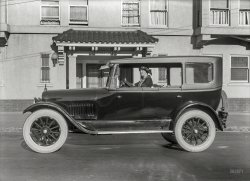
MAY CONTAIN NUTS

Search Shorpy
SHORPY ART

Framed or unframed, desk size to sofa size, printed by us in Arizona and Alabama since 2007. Explore now.
Join and Share
Ad-Free Shorpy
Shorpy is funded by you. Patreon contributors get an ad-free experience.
Learn more.

Recent comments
- Details, Details
- What's that building to the left of the tower?
- Coal Barges
- Bromo-Seltzer
- Inner harbor
- The Basin
- What a headache!
- Giant stepladder?
- Baldwin 62303
- Baldwin VO-1000
- Cold
- No expense spared
- Tough Guys
- Lost in Toyland
- And without gloves
- If I were a blindfolded time traveler
- Smoke Consumer Also Cooks
- Oh that stove!
- Possibly still there?
- What?!?
- $100 Reward
- Freeze Frame
- Texas Flyer wanted
- Just a Year Too Soon
- WWII -- Replacing men with women at the railroad crossing.
- Yes, Icing
- You kids drive me nuts!
- NOT An Easy Job
- I wonder
- Just add window boxes
Member Photos
The Shorpy
Print Emporium
Print Emporium
Search Shorpy
Search results -- 30 results per page
- Garbage Out: 1943
- ... catch the can when tossed back empty.
(The Gallery, Cars, Trucks, Buses, Gordon Parks, NYC) ... Posted by Dave - 07/27/2014 - 8:41pm -
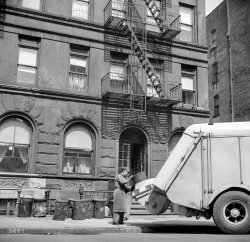
- Sachs Third Avenue: 1940
- ... operation for another 18 years. It used 1920's-era "Lo-V" cars until the late 1960's. For the last few years of the line's existence R-12 "Redbird" cars from 1948 operated on the line.
On April 28, 1973, revenue service ... Posted by Dave - 07/22/2013 - 6:24am -
![Sachs Third Avenue: 1940 November 5, 1940. "Sachs Quality Furniture Inc., 150th Street & Third Avenue, New York. General exterior, daylight. Morris Lapidus, Ross-Frankel Inc., clients." Large-format acetate negative by Gottscho-Schleisner. View full size.
Sachs' Bronx BranchIn Manhattan, Third Avenue terminates at 128th Street to become the Third Avenue Bridge. This street corner is in the South Bronx. It's now occupied by a pawn shop.
No Area Code NeededMelrose 5-5300 was the telephone number that Sachs Quality Furniture used in its radio commercials. It was sung in a jingle that became instantly recognizable. Glen Miller's Pennsylvania 6-5000 it wasn't, but it did deliver the message efficiently. Please don't confuse Sachs Quality Furniture with Saks 5th Avenue, the upscale Department store or Saks 34th Street of "Miracle on 34th Street" fame.
Ahead of its timeEven though it was constructed in the late 1930s, the Sachs storefront has many of the elements that defined "googie" coffee-shop architecture of the mid to late 1950s, from the lazy roof edge curves and tall skinny columns to the vast expanses of glass and the "floating" inner roof of the showcase.
[This is actually classic Streamline Moderne. -tterrace]
MemoriesI just spoke to a 92-year-old friend of mine who grew up a few blocks away from this location in the Bronx and he immediately recalled Sachs' radio jingle with its phone number: MElrose 5-5300.
Another ghostly remnantVisible at the upper right corner is some of the track structure for the late lamented Third Avenue El. This would be just north of the 149th Street station, where a free transfer was available to the Third Avenue station of the White Plains Road/Dyer Avenue subway lines, today's 2 and 5 trains.
Although the Manhattan and southern Bronx portions of the El closed in 1955, in anticipation of the (sarcasm alert) coming real soon! (/sarcasm alert) Second Avenue Subway, the Bronx portion from 149th Street north to the Gun Hill Road terminal remained in operation for another 18 years. It used 1920's-era "Lo-V" cars until the late 1960's. For the last few years of the line's existence R-12 "Redbird" cars from 1948 operated on the line.
On April 28, 1973, revenue service finally ended on the Bronx portion of the Third Avenue El, although there was a "fantrip" for rail enthusiasts the following day. The R-12's went to Flushing 7 line, where they ran for about another decade before being scrapped. Unlike the Manhattan portion of the Third Avenue El, which came down almost as soon as service ended in 1955, the Bronx section north of 149th Street wasn't demolished until several months after the end of service. Some of the old line's steelwork is still visible at the Gun Hill Road elevated station on the 2 line.
Aware that the Bronx Third Avenue El's closing could be a financial burden for the residents of the mostly lower-income neighborhoods along the line, who normally would have to pay separate fares to ride buses to the nearest remaining subway stations, the Transit Authority created a new bus line following the El's route and offering free transfers to the subway. This arrangement lasted until 1996, when the MetroCard fare card allowed free subway-bus transfers systemwide.
Sach's jingleI too, remember the MElrose 5-5300, along with many other jingles of the time. I'm sure some will recall "National Shoes ring the bell, for all smart women who want to dress well." And, "Nedicks B1." For those of us who were youngsters in the early forties probably remember Tom Mix's song which started "Shredded Ralston for your breakfast" and ended with "Take a tip from Tom, go an tell your mom, Shredded Ralston can't be beat." Ah those memories . . .
(The Gallery, NYC, Stores & Markets)](https://www.shorpy.com/files/images/SHORPY_5a05929u.thumbnail.jpg)
- Beauty & the Beast: 1922
- ... snapped at Hershey PA, October 2011.
(The Gallery, Cars, Trucks, Buses, Chris Helin, San Francisco) ... Posted by Dave - 08/26/2018 - 1:44pm -
![Beauty & the Beast: 1922 San Francisco circa 1922. "Paige 6-66 touring car." Advertised as "the most beautiful car in America." 5x7 glass negative by Chris Helin. View full size.
Got me!For a second there, I was thinking "THAT is one heck of a hood ornament!"
It is rather beautiful, but ...I give up. Where's the beast??
[Model 6-66. Hello? - Dave]
[Aaarrgh - bohneyjames]
A most beautiful carA few minor differences, but here is a survivor, snapped at Hershey PA, October 2011.
(The Gallery, Cars, Trucks, Buses, Chris Helin, San Francisco)](https://www.shorpy.com/files/images/SHORPY-1348.thumbnail.jpg)
- Maine Street: 1910
- ... there!
View Larger Map
(The Gallery, Cars, Trucks, Buses, DPC, Stores & Markets) ... Posted by Dave - 09/04/2012 - 11:54am -
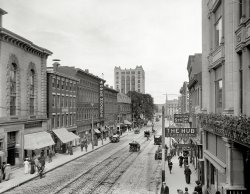
- Washington, D.C.: 1935
- ... be passed off as a modern apartment complex, only the cars and the dress style gives away the time period.
Everything but the ... Posted by Dave - 02/07/2013 - 9:09pm -
![Washington, D.C.: 1935 Washington tenements, Nov. 1935. View full size. Photo by Carl Mydans.
Great PhotoMy father would have been 10 years old in 1935. Looking carefully at the detail of this photo, one wonders if they had plumbing for bathrooms. It's obvious clothes dryers were not in this time period, hence all the clothes on clothes lines. It looks like wash basins were used for seating on the back porches.
The problem with B&W photos, although it is nostalgic and it forces you to really look for detail, it makes most photos look "dirty" because you can't see any color. It also gives it a sad ambience. Most people in these older B&W photos are not smiling. Maybe it was the depression era. If these photos were in color, it would be a whole completely different feel. When I think of the early years, I NEVER think of them in my mind in color. Always B&W. I wish I knew how to colorize some of these....just for a different feel.
[Here's a color photo from the same city, seven years later (1942). - Dave]
Sleeping PorchesThe back alleys of DC looked radically different 40-90 years ago, in part because "sleeping porches" were common. In the absence of air-conditioning families would typically sleep on these porches in high summer. Rickety porches like these were torn down, better built ones were incorporated into the house with walls in the 60s-70s and are a noticeable feature in Georgetown if you know what to look for.
TenementsIts amazing how this could be passed off as a modern apartment complex, only the cars and the dress style gives away the time period.
Everything but the clotheslinesThe view out the window into my alley in D.C. is very similar. Not so much laundry, but rugs and towels hang from porches. It's cleaner, most of the rubbish is in cans. Instead of washtubs and baskets the porches and alley are cluttered with storage bins, grills, coolers, etc. Yes, my alley looks very similar.
(The Gallery, Carl Mydans, D.C., Great Depression)](https://www.shorpy.com/files/images/8b26508uu.thumbnail.jpg)
- Lights Up: 1929
- ... platforms more appropriate to the task.
(The Gallery, Cars, Trucks, Buses, Chris Helin, San Francisco) ... Posted by Dave - 10/17/2017 - 9:18am -
![Lights Up: 1929 San Francisco circa 1929. "Dodge Brothers truck at City Hall." Where illumination seems to be the order of the day (or night). 5x7 glass negative. View full size.
Shocking?This is very odd - why would there be three enormous, ugly, high-tension electrical towers on the lawn of the City hall? Just to provide lighting of the building? Moreover they don't seem to be connected to anything, or even to each other!
[Temporary lighting for an event held in the City Hall plaza. -tterrace]
Why we have OSHAWe have a guy with no "personal protective equipment" climbing a (metal) ladder (injury lawyers love ladder manufacturers) towards 12kV while the ladder is mounted on a bouncy truck with no stabilizers. Yikes!
[The ladder is wood. - Dave]
OK, that's a little better, but still...Yikes.
Another fine productof the Dodge Light Truck Division.
No change in 88 yearsI like to see how things changed over the years but the bell string wire insulators of 1929 look just like the bell string insulators of today.
It's all in your perspectiveThe natty vested ladder climber is nowhere near the tower. To get to the tower from his truck, you'd have to cross the sidewalk, go over a low wall, across another walk, then past the woman on the park bench and finally into the shrubbery. It's a camera lens depth of field effect. It looks as though ladderman is actually going to inspect the ordinary streetlight.
[What he's really doing is promoting Dodge Brothers trucks. The Helin glass negatives are not documentary photography; they're publicity photos. - Dave]
That said, as someone who worked for a major electric utility for two decades, if city hall called us up and asked for the loan of three or more spare 115kV transmission line towers, double-circuited ones at that complete with pre-installed insulators, to just act as temporary spotlight stands, we'd have laughed our heads off. Then quoted a big price if they were insistent.
Those things would have to be assembled and taken down fairly painstakingly. Typically 70 or 80 feet tall, you don't just load 'em on a flatbed and truck 'em on over. They'd be bent up and dinged lying flat. Although, judging by the lack of safety standards they might have done just that given a long enough truck. Crazy. Amazing somebody didn't figure out a cheaper way to build temporary lighting platforms more appropriate to the task.
(The Gallery, Cars, Trucks, Buses, Chris Helin, San Francisco)](https://www.shorpy.com/files/images/SHORPY-1228B.thumbnail.jpg)
- Gasoline Alley: 1926
- ... you get when you paint with rattle can.
(The Gallery, Cars, Trucks, Buses, D.C., Natl Photo) ... Posted by Dave - 09/06/2012 - 7:00pm -
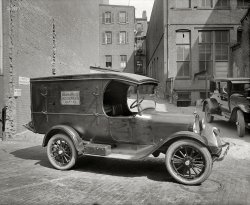
- Surely You Joust: 1927
- ... considerably quieter operation -- a plus in upper-bracket cars -- though at greater manufacturing cost and, alas, a significant increase ... for ostentatious wealth.
(The Gallery, Cars, Trucks, Buses, Chris Helin, San Francisco) ... Posted by Dave - 04/06/2017 - 2:08pm -
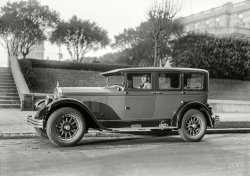
- Sidesaddle Automobilist
- ...
Someone oughta tell her ... her dog is dead.
(Cars, Trucks, Buses, G.G. Bain) ... Posted by Dave - 12/10/2007 - 5:03pm -
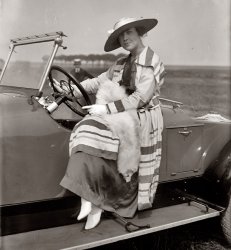
- The Wrong Side: 1938
- ... This scene just about has it all -- forlorn woman, old cars, derelict buildings, turkey, scrap pile, outhouse. Got to be a country ... Posted by Dave - 08/02/2017 - 9:26am -
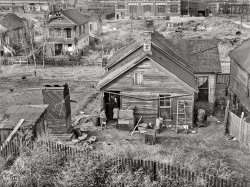
- Smash Hit: 1917
- ... of Venetian style blind on the outside.
(The Gallery, Cars, Trucks, Buses, D.C., Natl Photo) ... Posted by Dave - 02/03/2015 - 9:10am -
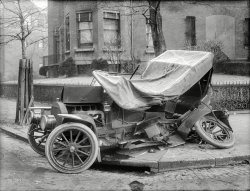
- 1st Women's Fire Dept.: 1929
- ... net," boys. Oh, the good old days...)
(The Gallery, Cars, Trucks, Buses, D.C., Natl Photo) ... Posted by Dave - 09/09/2011 - 1:11pm -
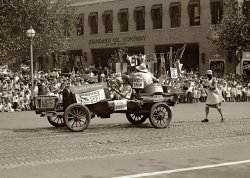
- Death Car: 1923
- ... by DC's quadrant system at some point.
(The Gallery, Cars, Trucks, Buses, D.C., Natl Photo) ... Posted by Dave - 09/12/2011 - 12:11pm -
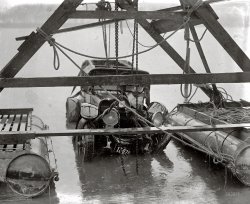
- Unhitched: 1941
- ... to get a color --- blue from the cold!
(The Gallery, Cars, Trucks, Buses, M.P. Wolcott) ... Posted by Dave - 05/07/2015 - 3:39pm -
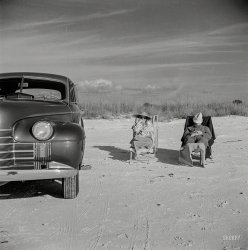
- Chicago Noir: 1942
- ... Yard This a hump yard, where a locomotive pushes cars up a small hill (behind the camera) and the cars are uncoupled individually or in groups to roll down the other side of the ... Posted by Dave - 09/06/2011 - 1:38pm -
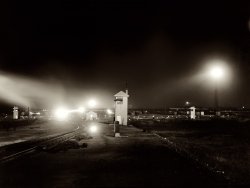
- Road of the Streamliners: 1939
- ... and a projecting headlight fairing.
(The Gallery, Cars, Trucks, Buses, Railroads, San Francisco) ... Posted by Dave - 02/11/2015 - 11:27am -
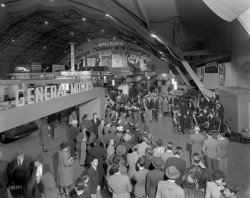
- Private Coach: 1931
- ... coach bodied by Eureka are also shown.
(The Gallery, Cars, Trucks, Buses, Chris Helin, San Francisco) ... Posted by Dave - 05/24/2017 - 12:59pm -
![Private Coach: 1931 San Francisco circa 1931. "Pierce-Arrow limousine." Latest entry in the Shorpy File of Funereally Funky Phaetons. 5x7 glass negative by Chris Helin. View full size.
Are you sure?A Pierce Arrow without the bigeye headlamps? I'm no expert but that's the first thing I noticed. Also those not period correct 1" whitewall tires.
[You're right about one thing. - Dave]
Service carIf you look on the back of the car, you will see what looks like a door handle and no trunk rack. This leads me to think that this is some type of service car, along the lines of a private ambulance.
Perchance an AmbulanceThe 1924 Pierce Arrow Model 33 Ambulance depicted here
https://en.wheelsage.org/pierce-arrow/model_33/79830/pictures/z35bjq/
appears to be a predecessor.
Barrett's your visionary tire manNot only did the Akron based India Tire Company manufacture skinny whitewalls in the 1930s, in the late 1920s they offered red striped tires decades before it became a fad in the 1960s.
San Francisco City employees could get the same discount as the City Purchasing Agent did—this from the March 1932 edition of the "San Francisco Municipal Record"
Born 1926 or EarlierThe hood, wheels, and fenders expose this vehicles origins as a 1921 to early 1926 Pierce-Arrow Series 33. The grouping of the hood louvers in the pattern shown was not used on any other model or during any other model years. By 1931 the hub caps covered the lug nuts as well as the axle ends, and the side mounted spare tires were placed much deeper into the front fenders.
Possibly this vehicle was converted to the body style shown here at the time of the photo. When produced without the headlights built into the fenders, most Pierce Arrows of the early 1920s came from the factory with drum style headlights as shown in the photo below of a 1923 Pierce-Arrow Model 33 limousine. A 1924 ambulance and a 1931 Pierce-Arrow funeral coach bodied by Eureka are also shown.
(The Gallery, Cars, Trucks, Buses, Chris Helin, San Francisco)](https://www.shorpy.com/files/images/SHORPY-1171.thumbnail.jpg)
- Philly Up: 1943
- ... From the visible trim looks like a '40.
(The Gallery, Cars, Trucks, Buses, Gas Stations, Jack Delano, Philadelphia) ... Posted by Dave - 03/30/2017 - 5:03pm -
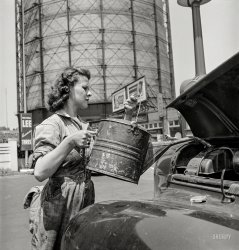
- French Market: 1910
- ... had to walk on those uneven stones while pulling loaded cars.
(The Gallery, DPC, New Orleans, Stores & Markets) ... Posted by Dave - 08/14/2012 - 4:03pm -
![French Market: 1910 Circa 1910. "French Market, New Orleans." Our second look at the market at N. Peters and Decatur streets. Detroit Publishing Co. glass negative. View full size.
"The House Next Door"J.E. Dodson was an accomplished Broadway actor who appeared in several shows. "The House Next Door" was produced on Broadway by George M. Cohan & Sam Harris in 1909.
The French Market is eternalI lived in New Orleans in the late 1970s and early 80s and shopped at the French Market quite often. It's amazing how little it changed from this photo taken seventy years earlier, except for the clothing. I'm sure if I were to visit there again, it would be much the same.
Where the horsepower hits the streetJudging by the lack of wires over the tracks, and the generous, ah, deposits between the large cobbles, these tram tracks must have still been horse powered. Keep your skirts up ladies! And yes, we have green bananas!
[The streetcars here were electric, powered from the wires seen overhead. - Dave]
Mind the gapLook at those gutters.....deep as trenches! It's so pleasant to see Decatur free of bead and T-shirt shops. Central Grocery, half a block from where we're standing, was four years old when this photo was taken.
Mr. Dodson... playing in "The House Next Door," advertised on the utility pole, in a photograph taken the same year:
Cartoon fodder!There is a little drama going on here between that dog and the cat.
Glad the horses were sparedDave is correct, I missed the trolley wires amongst the other overhead wires. Glad that horses no longer had to walk on those uneven stones while pulling loaded cars.
(The Gallery, DPC, New Orleans, Stores & Markets)](https://www.shorpy.com/files/images/4a23693u.thumbnail.jpg)
- The Pergola-Casino: 1911
- ... while taking in the picturesque view."
(The Gallery, Cars, Trucks, Buses, DPC, Eateries & Bars, Kids) ... Posted by Dave - 11/09/2019 - 7:50pm -
![The Pergola-Casino: 1911 Lake George, New York, circa 1911. "The Pergola-Casino, Fort William Henry Hotel." Two years après-feu. 8x10 inch dry plate glass negative, Detroit Publishing Company. View full size.
The GrottoAfter visiting The Casino, we might go to The Grotto, provided that it has been rebuilt as well. Read the Hotel's history here.
The carOn the left is a 1911 Packard. The plate is visible so if the records existed we would know whose car it was.
New in 1911From https://www.fortwilliamhenry.com/resort-overview/history/:
"A year after the fire [in 1909], the hotel’s owners, the Delaware & Hudson Railroad, committed to rebuilding a much smaller hotel that would accommodate around 150 guests. On June 17, 1911, the second Fort William Henry Hotel opened for business. The white stucco building was 3 stories with a red tile roof, and was designed to be less susceptible to a catastrophic fire, like the one that destroyed the first hotel.
While the hotel itself was smaller, the emphasis on being a lavish resort remained. The most notable new feature was the marble and concrete pergola along the lakefront. A walkway connected the hotel to the pergola. Guests would cross a bridge over the shore road which is now the location of the Beach Road public parking lot. People danced to music provided by a resident orchestra, and enjoyed refreshments while taking in the picturesque view."
(The Gallery, Cars, Trucks, Buses, DPC, Eateries & Bars, Kids)](https://www.shorpy.com/files/images/SHORPY-4a24324a.thumbnail.jpg)
- Caught in Passing: 1941
- ... business coupe Could be Marlowe.
(The Gallery, Cars, Trucks, Buses, Chicago, Edwin Rosskam) ... Posted by Dave - 05/05/2014 - 12:42pm -
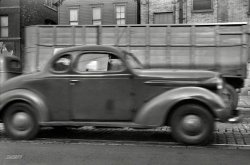
- The Louvers of Power: 1954
- ... "louvers" actualy mean venetian blinds?
(The Gallery, Cars, Trucks, Buses, D.C., Theodor Horydczak) ... Posted by Dave - 04/25/2017 - 7:32pm -
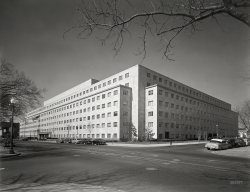
- Bright Eyes: 1931
- ... The amazing and rewarding Shorpy!
(The Gallery, Cars, Trucks, Buses, Chris Helin, San Francisco) ... Posted by Dave - 04/08/2015 - 11:48am -
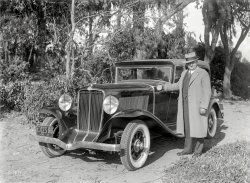
- Island Queen: 1907
- ... vents in the sidewalk for subways). The wheels of the cars going over them make a noise that has led to the Roebling sometimes being ... Posted by Dave - 07/29/2012 - 2:39pm -
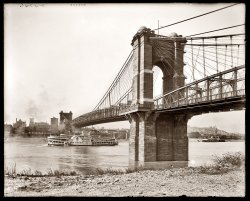
- Traffic-Stopper: 1928
- ... came into the driver's field of view.
(The Gallery, Cars, Trucks, Buses, Chris Helin, San Francisco) ... Posted by Dave - 06/21/2018 - 12:34am -
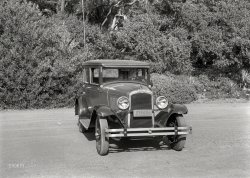
- The New Nash: 1921
- ... 1917 edition of the Washington Times.
(The Gallery, Cars, Trucks, Buses, D.C., Natl Photo) ... Posted by Dave - 10/20/2013 - 2:15pm -
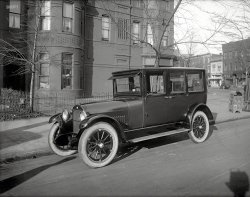
- Wash Walker: 1939
- ... The Chevy is probably a 1935 model.
(The Gallery, Cars, Trucks, Buses, M.P. Wolcott) ... Posted by Dave - 03/29/2015 - 9:10pm -
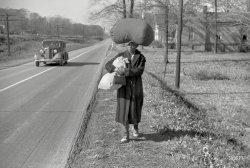
- The Bucking Buick II
- ... View full size. G.G. Bain Collection.
(The Gallery, Cars, Trucks, Buses, G.G. Bain, NYC) ... Posted by Dave - 09/08/2011 - 11:52am -
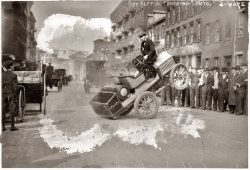
- Swiping Coal: 1917
- ... Southern rail yard.
Whenever there was a line of coal cars parked in the yard the word soon spread all around Goat Hill, Remington ... ant hill intruder.
Some of the boys would climb up the cars and start kicking the mounds of coal to the adults and young girls below ... Posted by Dave - 09/30/2020 - 2:36pm -
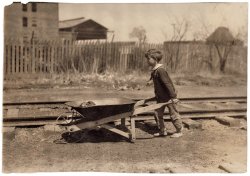
- Mona Lisa: 1920
- ... yet fallen to redevelopment:
(The Gallery, Cars, Trucks, Buses, Chris Helin, San Francisco) ... Posted by Dave - 11/14/2016 - 3:09pm -
